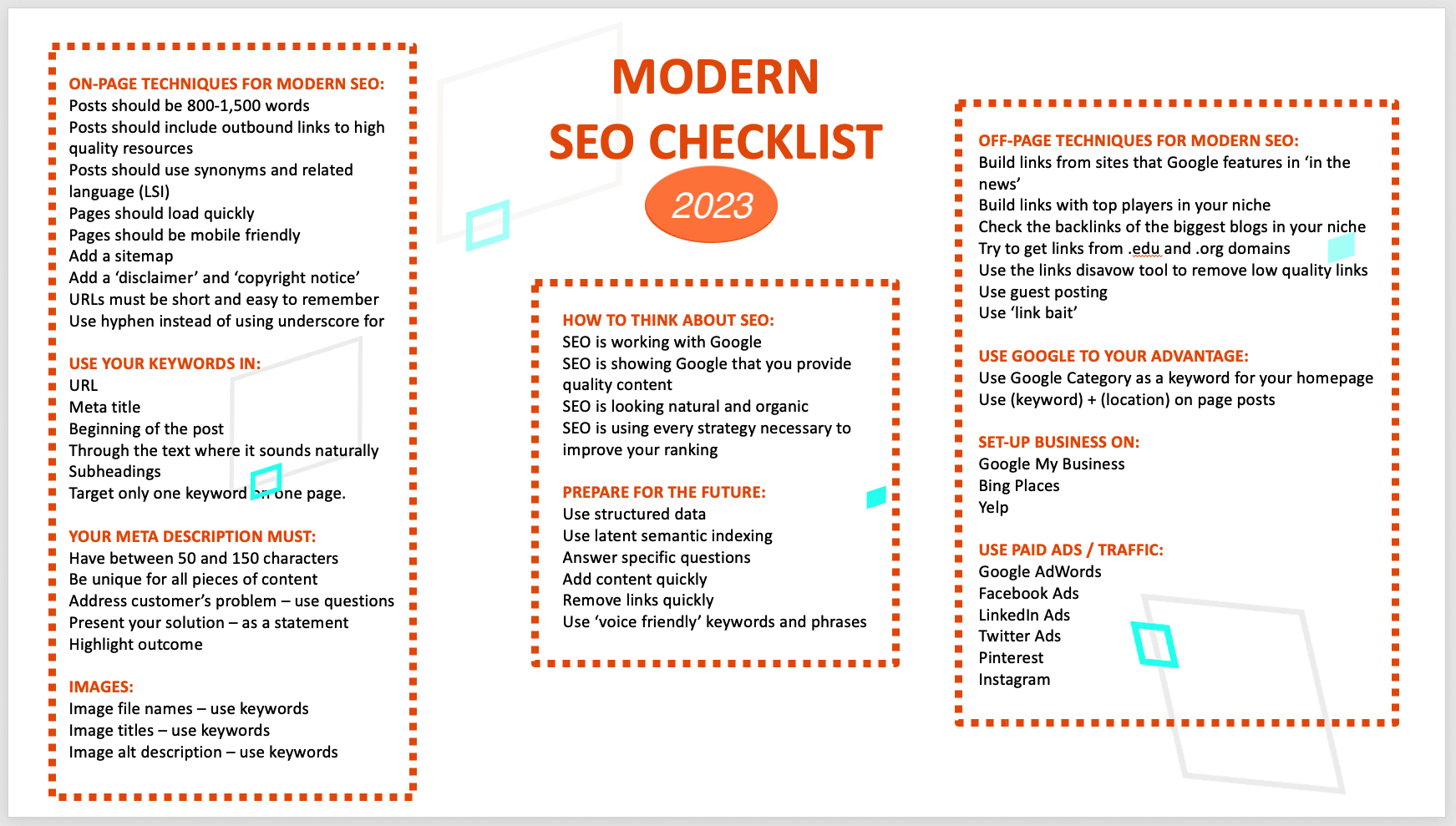Website SEO Checklist
Please feel free to use any of my resources and improve your website. You can use and share these resources at your own will, I am always happy to be useful.
Updated: 04/01/2023

Download the full PDF – it’s free and easier to use.
DOWNLOAD PDF
The best product in the world is worth nothing if no one knows about it. The following checklist will show you some useful SEO strategies and the best ways to get traffic to your website. It also gives you an idea of how to think about SEO and how to prepare for the future.
How to think about SEO
- SEO is working with Google
- SEO is showing Google that you provide quality content
- SEO is looking natural and organic
- SEO is using every strategy necessary to improve your ranking
Prepare for the future
- Use structured data
- Use latent semantic indexing
- Answer specific questions
- Add content quickly
- Remove links quickly
- Use ‘voice friendly’ keywords and phrases
Outdated SEO strategies
- Private blog networks
- Link spam
- ‘Google bombs’
- Keyword stuffing
- 500-word posts
- Link farms
Avoid:
- Duplicate content
- Duplicate meta titles
- Duplicate meta descriptions
- Optimising more than one page for the same keyword
- Keyword stuffing
- Buying links
On-page techniques for modern SEO
- Posts should be 800-1,500 words
- Posts should include outbound links to high quality resources
- Posts should use synonyms and related language (LSI)
- Pages should load quickly
- Pages should be mobile friendly
- Add a sitemap
- Add a ‘disclaimer’ and ‘copyright notice’
- URLs must be short and easy to remember, whenever possible
- Use hyphen instead of using underscore for URLs
Use your keywords in:
- URL – when this is possible, it is not compulsory anymore
- Meta title
- Beginning of the post
- Through the text where it sounds naturally
- Subheadings
- Target only one keyword on one page.
Your meta description must:
- Have between 50 and 150 characters
- Be unique for all pieces of content
- Address customer’s problem – use questions
- Present your solution – as a statement
- Highlight outcome
Images:
- Image file names – use keywords in image filenames
- Image titles – use keywords in image titles
- Image alt description – use keywords in image alt descriptions
Off-page techniques for modern SEO
- Build links from sites that Google features in ‘in the news’
- Build links with top players in your niche
- Check the backlinks of the biggest blogs in your niche
- Try to get links from .edu and .org domains
- Use the links disavow tool to remove low quality links
- Use guest posting
- Use ‘link bait’
Use Google to your advantage:
- Use Google Category as a keyword for your homepage
- Use (keyword) + (location) on page posts
Set up business on:
- Google My Business
- Bing Places
- Yelp
Business details such as address, phone number, etc:
- Need to be consistent across the web
- Displayed in the footer of your website
Use paid ads / traffic
- Google AdWords
- Facebook Ads
- LinkedIn Ads
- Twitter Ads
Note: Paid traffic is not compulsory to make your website successful. Anyway, it is a good idea to invest a small amount of money to test an important landing page and optimise that page for the highest conversion before promoting it.
Analyse your performance
- Set up Google Analytics
- Set up Google Search Console (former Webmaster Tools)
Social techniques for modern SEO
Every good search optimisation campaign (or consultant) should take into consideration social media important aspects such as:
- Social profiles
- Profiles visually similar across all social networks
- Good specific content
- Prominent share buttons
- Featured image optimised for sharing
- “Follow me” buttons on the website
- Local SEO
- And more…
